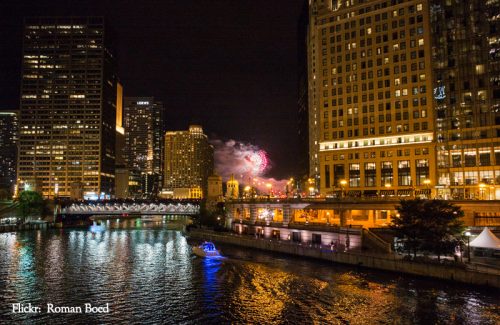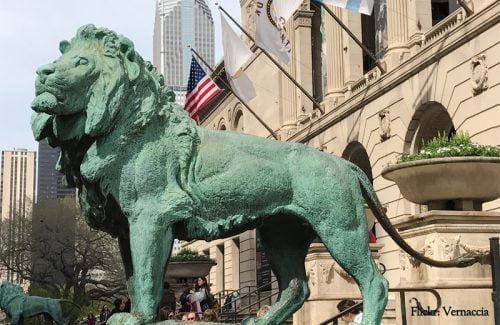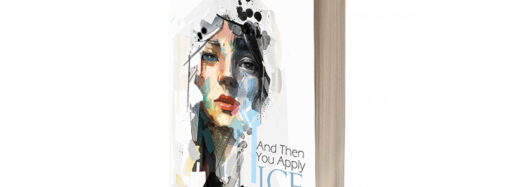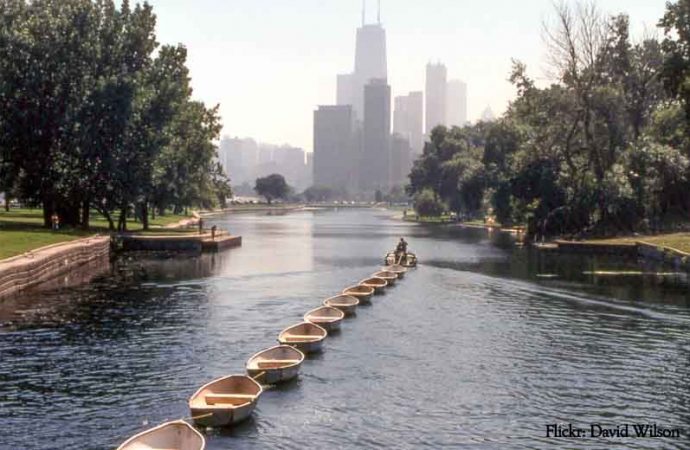The following passages describing the Windy City of Chicago located in the midwestern State of Illinois are taken from Winter in Chicago and Winter Gets Hot by David M. Hamlin. Both books from the Emily Winter mystery series, which are based in Chicago, are available from Open Books Direct.
Marshall Field’s

Ladies who lunched in the elegant surroundings of the Marshall Field’s Tea Room were invariably well-dressed and well-coifed. Kirstin Bonner fit right in. A striking brunette in a smartly tailored suit, she strode across the room to Emily’s table with considerable authority, a woman at once comfortable and confident. Emily liked her before a word was spoken. As soon as their tea and a plate of finger sandwiches arrived, Emily provided enough background to persuade her companion that she was not seeking a salacious or sensational story but the news behind such an unexpected and inexplicable suicide.
Billy Goat Tavern

She had picked at the tepid banquet food until the table was bussed; most of her meal remained on her plate when they took it away. Holding Ben’s arm as they left, Emily demanded a visit to the Billy Goat Tavern where, ravenous, she wolfed down two cheeseburgers of her own and the last two bites of Ben’s.
Michigan Avenue Bridge

On Thursday afternoon at 4:45, as the sky was darkening and the rush hour was at the starting line, JD the DJ cued a block of ten songs in a row and walked out of WEL’s main broad-cast studio. Decker and his engineer moved quickly to the elevator, a canvas duffel bag slung over Decker’s shoulder. They rode the elevator to the parking area in the basement and tossed the bag onto the passenger seat of the station’s mobile broadcast van and drove it out of the garage and onto the bridge which crossed the Chicago River at Michigan Avenue and Wacker Drive.
Decker pulled the van into the center lane of the bridge, grabbed the duffel bag and climbed out of the van, locking it behind him. His engineer threaded a long microphone cord through a slit at the top of the passenger window and then locked himself in.
On his engineer’s cue, John Decker began broadcasting live from the bridge, inviting any so inclined to join him. Cars and trucks tried to dodge around the parked van, but it didn’t take long for traffic to back up in both directions. Soon enough, both Michigan and Wacker were in gridlock, blaring horns and angry shouts echoed off the walls of the surrounding buildings as a crowd grew steadily.
In the cacophony, Jon Decker solemnly declared the death of “Hits 980.” For the next several minutes, with the crowd cheering him on, Jon Decker took one tape cassette after another out of the duffel and heaved them over the railing into the icy water below.
The cassettes flew off the bridge in order, red, blue, red, blue, red, green until there were ten cassettes remaining of the original 25.
As each of the last ten sailed out the damp evening air, the crowd and JD the DJ counted down.
“Ten. . .nine. . .eight. . .two. . .ONE!”
When the last cassette lofted out over the water, the crowd exploded in a rousing cheer. As two uniformed officers came up the sidewalk toward him, Decker’s engineer climbed out of the van’s back door and set the lock before he closed it.
Friends, I’m sorry to say I have to leave you now. It has been my honor and joy to share good music with you here on the El, but the time has come for us to go our separate ways. I hope to talk with you soon, but until then, I promise you that rock and roll – good rock and roll on good radio stations – will never die.
The two officers drew near and Jon Decker stood tall, one arm raised above his head.
JD the DJ signing off, friends. Shine On, Chicago! Shine on and on. . .
Then he rifled the keys to the van over the railing and into the river, waved good bye to the crowd and walked down the Avenue, his long coat flapping and his head bent low against the wind.
Robie House

Like most true Chicagoans, Emily celebrated her city’s modern architecture with the same joy and enthusiasm accorded the Bears, the Bulls, the Blackhawks and one, but only one, of the two baseball teams (in Emily’s case, the Cubs). From Louis Sullivan, who taught the world that buildings could soar to the sky, to Mies Van Der Rohe’s spare, clean structures to the Hancock Building, wearing its muscular beams on the outside for all the world to see, Chicago serenaded its citizens with stunning beauty every single day.
Yet, for all that, only one building touched Emily’s soul. She stopped on the sidewalk and took a deep breath as Robie House enchanted her anew. The lines flowed in a way which made the house appear to be somehow aloft, as if it were just too beautiful to be tethered to the earth. From the outside, its elegance humbled Emily; the first time she saw the interior, she wept.
She walked slowly up and down the sidewalk, her eyes never leaving the building. For almost half an hour, she let Frank Lloyd Wright’s glorious structure delight her. By the time she hailed a cab and headed north, her mood was placid and her discomfort abated.
Wrigley Field

Before the Cubs recorded a single out, they were down by four runs. By the time the game ended, the Cardinals had run up 21 runs to the Cubs’ four. All but a few of entire Herberger Whittier Stineford & Bovie staff were too giddy, if not too intoxicated, to care and they all had a grand time. Emily didn’t get to sit with Mr. Stineford. Instead, she was between Ben on one side and a legal secretary on the other; Ben spent most of the game schmoozing clients among the gathering and the secretary didn’t know enough about baseball to understand the concept of a foul ball.
And the weather had turned miserable by the second inning, chilly and damp with a wind off the lake which caused some fans to break out fleece Cubs blankets and others to wear ear muffs and heavy scarves.
The best part of the afternoon was its end. Ben and Emily walked home from Wrigley, holding hands and talking all the way.
Chicago Art Institute

They ended up getting sandwiches to go because Heidi wasn’t comfortable talking about the murder in the small room where others could hear what she said. They carried their paper sacks and drinks over to the Art Institute where they sat between the two stone lions on either side of the broad cement staircase leading into the museum.
Lincoln Park

A warm spring sun cast dappled shadows across the expanse of park in front of their condo. The trees weren’t quite fully clothed, but there was enough foliage to create interesting patterns on the grass as it slowly grew ever greener.
The park was active. A handful of children were playing softball beside a picnic table which was decorated for somebody’s birthday. A fair number of joggers were doggedly pacing themselves through the park and a group of high school kids were noisily and happily winging a Frisbee at one another across a wide swath of open space.
Ben and Emily had enjoyed a leisurely breakfast and shared the Sunday papers and then dressed to take a long walk in the park.
Ben was using his walking stick; he didn’t have any need for it but he thought it a sophisticated accessory. Emily thought it a bit silly but she also admired his determination to maintain bygone vestiges of gentlemanly, if not courtly, sensibilities. They were walking south without destination, enjoying the sun and the parade of people.






























Leave a Comment
Your email address will not be published. Required fields are marked with *